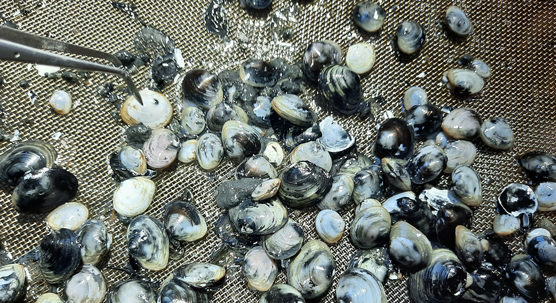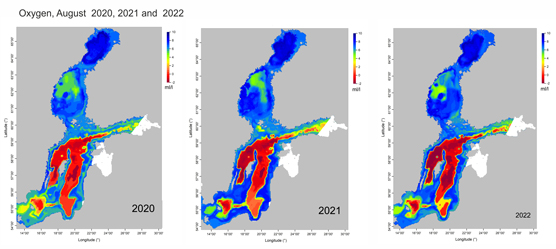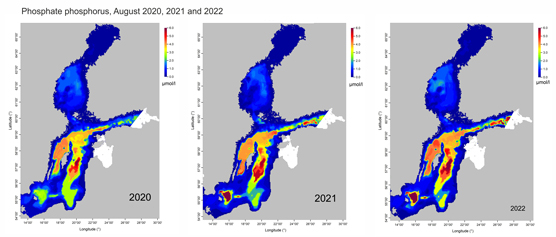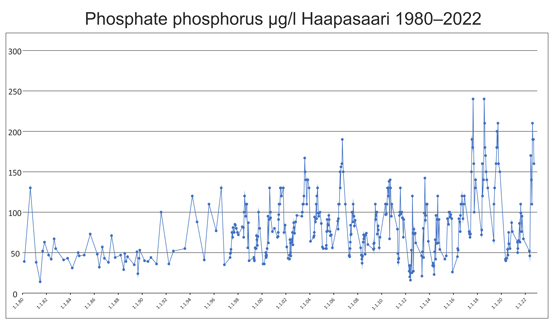Press release 2022-12-01 at 8:30

Baltic clams from the Archipelago Sea. Even at the deepest depths of the Archipelago Sea, the benthic animal communities were clearly more populous and diverse than in the Gulf of Finland. © Seppo Knuuttila
The Finnish Environment Institute monitored the state of Finland's marine areas in August. The sea bottom in the deep parts of the Gulf of Finland were oxygen depleted, and the oxygen situation of the deep bottom areas of the coast had deteriorated, which was also reflected in higher levels of phosphate phosphorus and reduced numbers of benthic animals. The oxygen and benthic animal situations are clearly better in the Archipelago Sea than they are in the Gulf of Finland. Algae levels in the Gulf of Finland appear to have declined, despite the annual appearance of blue-green algae.
In the 2010s large salt pulses came into the Baltic Sea from the North Sea, and their effects on the Gulf of Finland have been clearly seen in recent years. The pulses pushed anoxic water with high nutrient levels from the depths of the main basin of the Baltic Sea into the Gulf of Finland. The oxygen situation at the bottom of the Gulf of Finland has been poor since then, except for the winter of 2019/2020 when there was no ice cover (Fig. 1).
In August 2022 the deepest part of the Gulf of Finland was largely depleted of oxygen, and hydrogen sulphide was detected near the bottom at several sampling stations studying the depths. The highest levels of phosphorus and nitrogen in 50 years of monitoring (Fig. 2) were measured in waters near the bottom in eastern parts of the Gulf of Finland. The high level is likely the result of water surging from the depths of the main basin of the Baltic Sea. This water has remained isolated, collecting nutrients released from the bottom.

Figure 1. Oxygen situation near the seabed in the open sea from the southern Baltic Sea to the Bay of Bothnia in August 2020, 2021 and 2022. © SYKE Data: SYKE and SMHI

Figure 2. Phosphorus concentrations on the seafloor in the open sea from the southern Baltic Sea to the Bay of Bothnia in August 2020, 2021 and 2022. © SYKE. Data: SYKE and SMHI
The flow of water from the depths of the main basin of the Baltic Sea into the eastern part of the Gulf of Finland leads to density layering. As a result of this the oxygen levels both in the depths of the open sea, as well as that of the water close to the bottom of outer coastal areas and the archipelago, deteriorates, raising the level of soluble phosphate phosphorus (Fig. 3). When the oxygen situation at the bottom deteriorates, it is also reflected in the benthic fauna. In the 30 established monitoring stations on the coast of the Gulf of Finland, benthic fauna has mainly been quite scarce in this century so far. Dominating at most observation locations are Marenzelleria spp, a group of invasive burrowing polychaetes that can endure low oxygen levels.

Figure 3. The content of phosphate phosphorus in waters near the bottom at the Haapasaari observation station in Kotka at the depth of about 68 metres in 1980-2022. © SYKE
Archipelago Sea
Oxygen levels measured in open water in northern parts of the Archipelago Sea in August 2022 were slightly below the long-term averages, while nutrient levels were higher. In the southern part, the oxygen situation was better than in previous years and nutrient levels were below the long-term averages.
After a six-year gap, this year's coastal monitoring cruise of the Finnish Environment Institute, together with the ELY Centre of Southwest Finland, examined the state of benthic animal communities also in the southern part of the Archipelago Sea. Even at the deepest depths of the Archipelago Sea, the benthic animal communities were clearly more populous and diverse than in the Gulf of Finland. The primary factor contributing to this was the better oxygen situation at the bottom of the marine area.
Gulf of Bothnia
The oxygen content of the depths of the Bothnian Sea was better in August 2022 than it has been in recent years. Above average phosphorus levels were measured especially in the Bay of Bothnia. The likely reason for this is the flow of more nutrient-rich water from the Bothnian Sea to the Bay of Bothnia and partly also nutrient runoff from land. Nutrient levels measured in the Bay of Bothnia are nevertheless low compared with other marine areas.
Northern part of the main basin of the Baltic Sea
The oxygen situation of the main basin of the Baltic Sea was unchanged, and deep water of the main basin from 70 metres down was low in oxygen or had no oxygen at all. Nutrient levels in the main basin were at an average level. Very large blooms of algae and algae rafts were seen locally in the main basin.

Figure 4. Oxygen profile from the southern Baltic Sea to the Bay of Bothnia in August 2020, 2021 and 2022. © SYKE Data: SYKE and SMHI
Algae rafts observed in the main basin of the Baltic Sea and in the Gulf of Finland
August in Finland had record-high temperatures this year, and water temperatures of the surface layer of the sea were high. Extensive rafts of blue-green algae were observed in the open sea areas of the main basin of the Baltic Sea and the Gulf of Finland during the monitoring cruise of the research vessel Aranda in early August. On a coastal monitoring cruise conducted in the second half of August, extensive blooms of blue-green algae were seen especially in western parts of the Gulf of Finland and the Archipelago Sea.
Oxygen-free water with high levels of phosphorus coming from the depths of the main basin of the Baltic Sea remains a key factor affecting the algae situation in the Gulf of Finland. When salt layering occurs, this enables the release of phosphorus from the bottom of the Gulf of Finland itself.
About the monitoring cruises
The Finnish Environment Institute monitors the state of the Baltic Sea during cruises conducted four times a year on the research vessel Aranda and one coastal monitoring cruise with a smaller vessel. The open sea cruise in August 2022 extended to the sea areas from the eastern Gulf of Finland to the Bothnian Bay, and the coastal monitoring cruise extended to the coasts of the Gulf of Finland and the Archipelago Sea. The cruises are part of the monitoring of long-term changes in the state of the Baltic Sea and they serve the Monitoring Program for Finland’s Marine Strategy and the HELCOM Monitoring Programme of the Baltic Sea countries.
On the monitoring cruises, information is collected on the physics, chemistry, and biology of the Baltic Sea and on the rise of harmful substances from the bottom sediments to the surface. Based on the monitoring data collected it is possible to assess the oxygen situation, eutrophication, and possible changes occurring in plankton and benthic fauna.
The observations are based on cruises in July and August by research vessel Aranda and the research vessel Svea of the Swedish Meteorological and Hydrological Institute (SMHI).
The monitoring cruise of the research vessel Aranda on 8–19 August 2022 was led by Pekka Kotilainen and Maiju Lehtiniemi. The head of the coastal monitoring cruise in the Gulf of Finland and the Archipelago Sea on August 15–26 was Seppo Knuuttila.
Inguiries:
- Gulf of Finland: Maiju Lehtiniemi, Research Professor, Leader of the Aranda expedition, Finnish Environment Institute, tel. +358 295 251 356, firstname.lastname@syke.fi
- Baltic Proper and Gulf of Bothnia: Pekka Kotilainen, Senior Researcher, Leader of the Aranda expedition, Finnish Environment Institute, tel. +358 295 251 317, firstname.lastname@syke.fi
- Coastal monitoring of the Gulf of Finland and the Archipelago Sea: Seppo Knuuttila, Senior Research Scientist, Finnish Environment Institute, tel. +358 295 251 286, firstname.lastname@syke.fi
Pictures for media use: